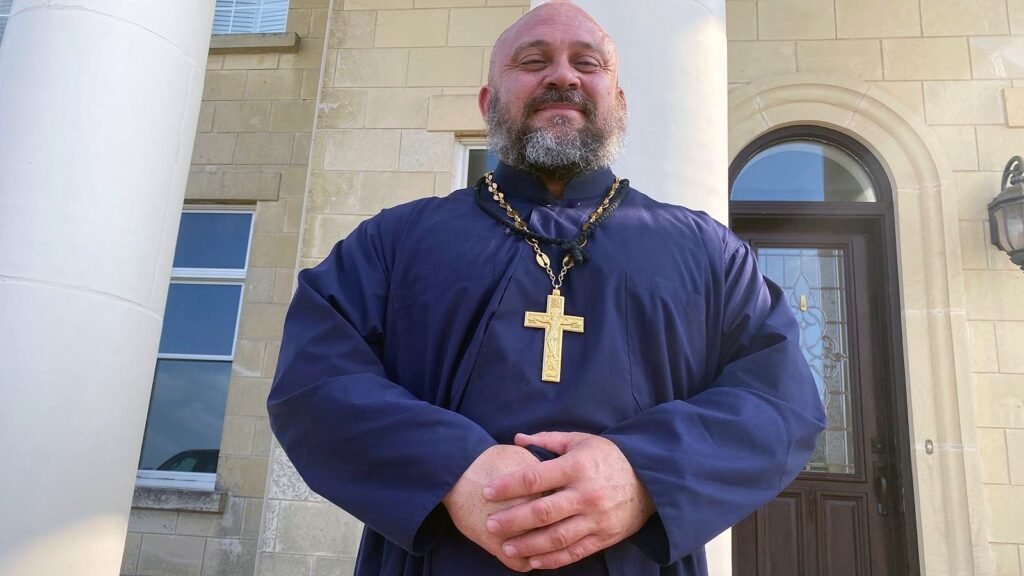A Surge in Masculine Appeal: Young American Men Embrace Russian Orthodox Christianity
In a striking trend, young men across the United States are gravitating towards the Russian Orthodox Church Outside Russia (ROCOR), drawn by its advocacy for an unapologetic form of masculinity. Father Moses McPherson, a priest in Georgetown, Texas, has been at the forefront of this movement, experiencing a remarkable influx of new followers, with his congregation growing threefold in just 18 months.
With a powerful physique and a following on social media, Father Moses openly critiques modern notions of masculinity. He targets behaviors he deems overly feminine—such as wearing skinny jeans or being meticulous about appearance—while promoting a robust view of manliness that appeals to young men seeking more traditional values. The priest often shares videos of himself engaging in weightlifting set to heavy metal music, reinforcing his philosophy that masculinity is enduring and vigorous.
An Unconventional Path to Faith
Many of Father Moses’s converts, like Theodore, a software engineer, report feeling a disconnect with contemporary American society. Despite having what many would consider a perfect life—a stable job and a loving partner—they feel an inner void, attributing this to a societal environment perceived as hostile towards traditional male roles.
“We’re told that wanting to be the breadwinner is a toxic viewpoint,” Theodore reflects. “That’s not how it should be.”
The movement seems to encourage a shift in family dynamics, with most converts choosing home-schooling for their children. This approach is seen as a means of imparting religious education while safeguarding their families from discussions around modern gender identities, which they view as detrimental.
A Demographic Shift Within Christianity
While the Orthodox Christian population in the U.S. is relatively small—making up about one percent of the overall population—the demographic is evolving. According to the Pew Research Center, the proportion of Orthodox Christians who are male has surged from 46% in 2007 to 64% in recent assessments. This shift reflects a broader trend of men seeking community and faith, particularly amidst the COVID-19 pandemic, which many say catalyzed their spiritual explorations.
Academics like Professor Scott Kenworthy note this phenomenon is not isolated to a single parish but is indicative of broader trends across various communities. The combination of online outreach and a shared vision of manliness seems to resonate with a significant number of young men.
Online Influence and Public Perception
Father Moses’s digital footprint is extensive, showcasing everyday moments—such as announcing his family’s growing number with the arrival of another child—which generates considerable engagement. This method of outreach, paired with a strong presence on platforms like Instagram, mirrors a larger trend where clergy are harnessing the internet to connect with potential converts.
Orthodox clergy often express their views on modern Western culture, asserting that it has become excessively feminized. Father Moses emphasizes that the values of Orthodoxy are not inherently masculine or feminine but rather represent a return to normalcy amidst what he perceives as a cultural shift towards emotionalism.
Table: Trends in Orthodox Christianity Participation
| Year | Percentage of Male Converts | Notable Trends |
|---|---|---|
| 2007 | 46% | Initial demographics recorded |
| 2023 | 64% | Surge in interest, particularly among younger men |
This growing interest in traditional values and masculinity among Orthodox Christians reflects a wider sentiment among a subset of young men who are searching for community, family, and a deeper sense of purpose. Whether as a reaction to modern society’s expectations or the pull of a historic faith, this trend highlights a fascinating intersection of spirituality and cultural identity in contemporary America.

